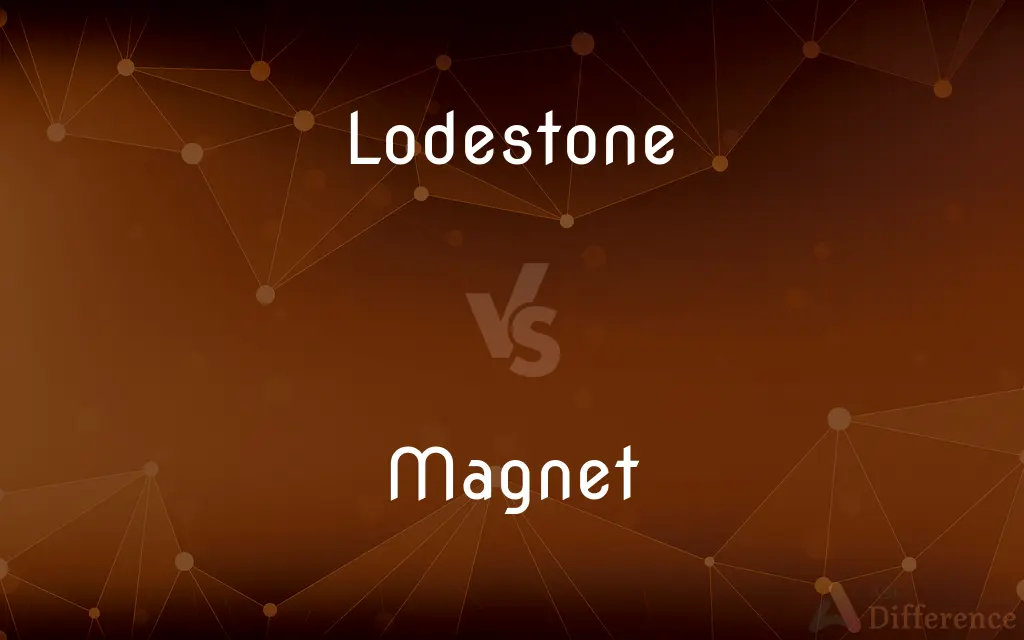Lodestone vs. Magnet — What's the Difference?
By Tayyaba Rehman & Urooj Arif — Updated on March 17, 2024
Lodestone is a naturally occurring magnetic rock, while a magnet can be either natural like lodestone or artificially made with enhanced magnetic properties.

Difference Between Lodestone and Magnet
Table of Contents
ADVERTISEMENT
Key Differences
Lodestone, also known as magnetite, is a naturally occurring form of iron oxide with magnetic properties, historically used in the earliest compasses. On the other hand, magnets can be artificially manufactured from various materials, including iron, nickel, cobalt, and their alloys, to have specific magnetic strengths and characteristics.
While lodestones are found in nature and have a natural magnetic charge, artificial magnets are created through various industrial processes, such as sintering or casting, allowing for a wide range of shapes, sizes, and magnetic strengths. Whereas magnets can be tailored for specific applications, lodestones have fixed magnetic properties determined by their natural formation.
Lodestones possess a permanent magnetism but with relatively weak magnetic fields compared to many artificial magnets. In contrast, artificial magnets can be engineered to have very strong magnetic fields, making them more versatile and useful in a wide array of modern applications, from electronics to industrial machinery.
The magnetic field of a lodestone is the result of the alignment of its internal mineral grains, which occurred naturally during the rock's formation. On the other hand, the magnetic field of an artificial magnet is usually the result of deliberate alignment of its atomic structure through manufacturing processes, including heating and applying external magnetic fields.
Despite their differences, both lodestones and artificial magnets follow the same fundamental magnetic principles, such as attraction and repulsion of opposite and like poles, respectively. However, the strength and stability of the magnetic fields can vary significantly between the two due to their different origins and manufacturing processes.
ADVERTISEMENT
Comparison Chart
Nature
Naturally occurring magnetic rock
Can be natural (like lodestone) or artificially made
Composition
Primarily made of magnetite (Fe3O4)
Made from various materials, including iron, nickel, cobalt
Magnetic Strength
Generally weaker compared to artificial magnets
Can range from weak to extremely strong
Use
Historical navigation, early compasses
Wide range of applications, from electronics to industrial machinery
Manufacture/Formation
Formed naturally in the earth
Artificial magnets are manufactured through industrial processes
Compare with Definitions
Lodestone
A naturally occurring magnetic mineral.
The ancient mariners navigated using lodestone.
Magnet
Can be natural or artificially made.
Scientists use powerful artificial magnets in research.
Lodestone
Composed mainly of magnetite.
Lodestone's magnetic properties are due to its iron oxide content.
Magnet
Made from various magnetic materials.
Modern magnets are often made from rare earth elements.
Lodestone
Formed through geological processes.
Lodestone is found in certain types of igneous and metamorphic rocks.
Magnet
Can have a very strong magnetic field.
The neodymium magnet held up several pounds with its magnetic force.
Lodestone
Has a relatively weak magnetic field.
The lodestone attracted small iron filings with its magnetic field.
Magnet
Used in numerous modern applications.
Magnets are essential in motors and generators.
Lodestone
Used historically for navigation.
Lodestone was a crucial component of the earliest compasses.
Magnet
Tailored magnetic properties through manufacturing.
The magnet's shape and strength were designed for specific industrial use.
Lodestone
A lodestone is a naturally magnetized piece of the mineral magnetite. They are naturally occurring magnets, which can attract iron.
Magnet
A magnet is a material or object that produces a magnetic field. This magnetic field is invisible but is responsible for the most notable property of a magnet: a force that pulls on other ferromagnetic materials, such as iron, steel, nickel, cobalt, etc.
Lodestone
A piece of magnetite that has magnetic properties and attracts iron or steel.
Magnet
An object that has the property, either natural or induced, of sustaining a magnetic field around it. Simple magnets attract metals such as iron and steel.
Lodestone
One that attracts strongly.
Magnet
An electromagnet.
Lodestone
A naturally occurring magnet.
Magnet
A person, a place, an object, or a situation that exerts attraction
A village that is a magnet for tourists.
Lodestone
(obsolete) The mineral magnetite.
Magnet
A piece of material that attracts some metals by magnetism.
Lodestone
Same as Loadstone.
Magnet
A person or thing that attracts what is denoted by the preceding noun.
He always had a girl on his arm – he's a bit of a babe magnet.
Lodestone
A permanent magnet consisting of magnetite that possess polarity and has the power to attract as well as to be attracted magnetically
Magnet
(internet) magnet link
Magnet
The loadstone; a species of iron ore (the ferrosoferric or magnetic ore, Fe3O4) which has the property of attracting iron and some of its ores, and, when freely suspended, of pointing to the poles; - called also natural magnet.
Dinocrates began to make the arched roof of the temple of Arsinoë all of magnet, or this loadstone.
Two magnets, heaven and earth, allure to bliss,The larger loadstone that, the nearer this.
Magnet
A bar or mass of steel or iron to which the peculiar properties of the loadstone have been imparted; - called, in distinction from the loadstone, an artificial magnet.
Magnet
(physics) a device that attracts iron and produces a magnetic field
Magnet
A characteristic that provides pleasure and attracts;
Flowers are an attractor for bees
Common Curiosities
Can artificial magnets be stronger than lodestone?
Yes, artificial magnets can be engineered to have much stronger magnetic fields than natural lodestones.
Can the magnetic strength of a lodestone be increased?
The magnetic strength of a lodestone is natural and relatively fixed, unlike artificial magnets, whose strength can be adjusted during their manufacturing process.
How do scientists use artificial magnets?
Scientists use artificial magnets in numerous ways, including in magnetic resonance imaging (MRI) machines and in research requiring strong magnetic fields.
Can lodestone be used to make a compass?
Yes, lodestone was historically used in the earliest forms of compasses for navigation.
How is lodestone different from regular iron ore?
Lodestone contains magnetite and has natural magnetic properties, unlike most iron ore, which is not inherently magnetic.
Are all types of magnets used in electronics?
Yes, various types of magnets, including both natural and artificial ones, are used in electronics, though artificial magnets are more common due to their tailored properties.
Can lodestone be demagnetized?
Like all magnets, lodestone can be demagnetized if heated above a certain temperature or subjected to a strong demagnetizing magnetic field.
Are all magnets made from lodestone?
No, while lodestone is a natural magnet, many modern magnets are artificially made from various materials.
Is magnetite the only magnetic mineral?
Magnetite is the most magnetic of all the naturally occurring minerals on Earth, but other minerals can exhibit magnetic properties under certain conditions.
Can magnets be recycled?
Magnets can be recycled, but the process can be complex due to their composition and the need to separate magnetic material from non-magnetic substances.
How are artificial magnets shaped?
Artificial magnets can be shaped into various forms during their manufacturing process to suit specific applications.
Are magnets harmful to electronic devices?
Strong magnets can interfere with or damage some electronic devices, particularly those with magnetic storage or sensitive electronic components.
Do magnets always have two poles?
Yes, all magnets, including lodestones and artificial magnets, have two poles: a north pole and a south pole.
How are lodestones formed in nature?
Lodestones are formed through geological processes, often involving the alteration of magnetite-rich rocks by natural magnetic fields during their formation.
Can the magnetic field of a magnet be seen?
While the magnetic field itself is invisible, its presence and direction can be visualized using iron filings or magnetic viewing film.
Share Your Discovery

Previous Comparison
Knight vs. Prince
Next Comparison
Severity vs. PriorityAuthor Spotlight
Written by
Tayyaba RehmanTayyaba Rehman is a distinguished writer, currently serving as a primary contributor to askdifference.com. As a researcher in semantics and etymology, Tayyaba's passion for the complexity of languages and their distinctions has found a perfect home on the platform. Tayyaba delves into the intricacies of language, distinguishing between commonly confused words and phrases, thereby providing clarity for readers worldwide.
Co-written by
Urooj ArifUrooj is a skilled content writer at Ask Difference, known for her exceptional ability to simplify complex topics into engaging and informative content. With a passion for research and a flair for clear, concise writing, she consistently delivers articles that resonate with our diverse audience.
















































